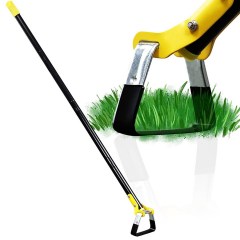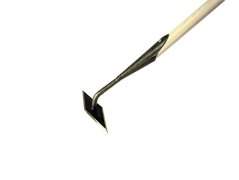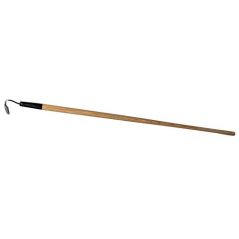BestReviews is reader-supported and may earn an affiliate commission. Details

This classic tool has some modern upgrades.
The head is made of steel made in the U.S. and it measures 5.25 by 6.25 inches. The shaft is fiberglass coated in polyester for lightness and durability. The handle has a rubber grip.
The lightness means you need to put some extra effort into chopping through tough soil.

This hoe uses a unique stirrup-like shape to excel at weeding.
The shape of this tool lets you cut through roots underground by dragging the hoe through your soil, so you don’t have to chop and hack at them like usual. The stirrup is 5.7 by 4 inches. It has a non-slip handle.
It’s on the heavy side. It can be hard to use on the toughest ground.

This hoe allows you to eliminate weeds with a push and pulling motion rather than a chop.
Well-made. A diamond head-shaped end. Sharp on the front and back. Easy to re-sharpen. Wide head. Allows for working in tight places. Tough metal head. Long strong handle.
The diamond points on this head are very sharp and could hurt you if you are not careful.

This double-sided hoe gives you more options for weeding in your garden.
The standard-shaped side chops through weeds and levels ground as usual while the pronged side is for digging out the deepest, toughest weeds and debris. The handle of this tool has a rubber grip.
The large, double-sided head adds some extra weight, making it tiring to use for long periods.

This hoe is sturdy and reliable but still lightweight and easy to use.
Comes with a sharp edge. Lightweight, but still has enough heft to cut into weeds without much effort. Quick and easy to use on small weeds. Nice balance with sharp corners to dig out tough weeds. Long handle.
Comes with a 60-inch handle, which may prove too long for some users.

We recommend these products based on an intensive research process that's designed to cut through the noise and find the top products in this space. Guided by experts, we spend hours looking into the factors that matter, to bring you these selections.

Garden hoes are one of the oldest tools used for agriculture and simple gardening tasks. A basic modern hoe consists of a small metal paddle or blade attached at a right angle to a long handle. This is in contrast to a shovel, which has a blade extending up and down in the same direction as the handle.
While a shovel allows you to dig deeply into the soil, a garden hoe is meant to scrape or chop surface layers of the ground. Hoes are ideal to prepare soil for cultivating gardens or digging up weeds. So, choosing the right one for you is simple right? Maybe not.
While you may be familiar with the basic shape of a garden hoe, there are many slight modifications to the traditional style which allow the tool to be more effective for specific tasks. You may want more than one in your shed to accommodate all your gardening needs. Keep reading for a few key considerations and questions you should ask before buying a new garden hoe.

Hoes come in many shapes and sizes to allow them to tackle different garden jobs. While some are better at pushing dirt and others better at pulling dirt, you want a garden hoe that performs the main function you will need.
Paddle hoes are the traditional and one of the most common types of hoe. They are designed for you to draw soil toward you. This style is excellent for breaking up dirt and preparing soil for planting. It can also remove weeds.
Ridging hoes have a pointed end on their paddle. As another kind of draw hoe, they are very effective at making ridges for vegetable gardens or planting.
Pronged hoes are created to do double duty. The usually have a small paddle hoe on one side and a forked edge on the other. While all hoes can help take care of weeds, this style is sometimes called a “weed” hoe. A weed hoe gives you greater precision to work the soil around thriving plants without hurting the plants.
Stirrup hoes have a style that looks like the stirrup on a saddle. It is a type of scuffle hoe, which means it is designed to use in a back and forth motion. The hoe is sometimes called a “push-pull” hoe or a “loop” hoe. A stirrup hoe allows you to get underneath a weed as you pull it toward you. The shape allows you to scoop out a weed or plant.
Steel is the head material of choice for most hoes on the market. This lightweight, hard-to-bend and strong material can make the tool very effective and long-lasting through the rigorous motion required when you use a hoe. You will find several types of steel used.
Welded steel is your least expensive option. There is a weld on this hoe head between the paddle and the L-shape that sets the paddle at a right angle to the handle. That weld will be a weak spot on your garden hoe and may break over time.
Stainless steel has the advantage of being the most resistant to rust and corrosion. It is molded, as one solid piece of metal without the welded joints. However, the shape may not withstand the repetitive chopping motion of hoeing as well as some other steels.
Wood is the most common material used in hoe handles. Strong wooden handles will be carved from a single piece of hardwood. Wood helps to soften the shock of hoeing on your shoulders and neck. Hickory is considered the best wooden handle. The disadvantage of wood is its susceptibility to rot, splitting, and deterioration over time. Wood handles are fairly inexpensive to replace.
Standard width on a traditional paddle hoe is six to seven inches. This length gives you a good multipurpose tool. It is the best tool to start with when you are learning how to use a hoe in the garden.
Extra wide blades are commonly 10 to 14 inches. They are good for digging up deep weeds, but can be more difficult to use. Before you buy a wide-blade hoe, make sure you feel comfortable with your skills.

A hoe with a cushion handle grip will have an area of extra padding for hand placement. The repetitive motion of hoeing a garden makes your hands very susceptible to blisters. These cushion grips help prevent hand injury. They also add a little width to the handle of your hoe, making it more comfortable for people with arthritis to hold.
Some garden hoes come with an adjustable handle known as a telescopic handle. These handles will extend from a short length that is appropriate for hand hoeing on your knees to a long length you can use standing up in a garden.
This function is convenient, but a telescopic handle is not as sturdy as a solid length handle. It will also not be quite as short as a hand hoe or as long as a standing hoe. A hoe is an inexpensive enough tool, so it may be better to opt for two hoes in different sizes.
Inexpensive: While some hand-held models cost less, decent full sized garden hoes will cost $15 to $20. These models will have wooden handles and a standard paddle shaped head. This tool should be of good quality, but may break down with heavy use.
Mid-range: Between $20 to $40 garden hoes will begin to come with added features, like tempered steel and fiberglass handles. Their construction will be better for heavy use.
Expensive: For $40 to $70 you will find a very heavy duty garden hoe. It should be made from tempered, hardened or stainless steel to last a long time and resist rusting. It will also come with a heavy duty fiberglass handle. Some specialty hoes will also fall in this price range.
A garden hoe will work best if it is sharpened on a regular basis.
A garden hoe is very effective when you know how to use it. Spend a few minutes reading up on how the hoe you chose is designed to work to make your time in the garden more efficient.
Hoes work best on small weeds. If your weeds are larger, you may need a forked hoe to help dislodge the root of the weed.
Clean as much dirt off of your hoe as you can and completely dry it off before you put it away to help prevent rusting while your tools are in storage.
For this shopping guide we focused on traditional long-handled garden hoes. When you are working in small areas, a short handled hand hoe may be what you need instead. We really like the Edward Tools hand hoe with a rubber handle that is comfortable on your hands and has a stainless steel head to resist rusting. It is a good weight and well made. HongyeTaja makes an extremely well made, tempered steel hand hoe. The hoe is very good for digging in the garden, but can also be used to chop big weeds or clear trails.

Q. How long should the handle of my garden hoe be?
A. Length does make a difference in a garden hoe handle, because the angle of the hoe will be different based on how you hold it. You need your hoe to be at a 25º to 30º angle to properly skim the surface of the soil. Taller people will need a longer handle to make sure they can comfortably hold the hoe at this angle without straining their backs and shoulders. Try holding the hoe at your belly button and examining the angle of the hoe head to see if the length of your handle is correct. If you cannot adjust the angle of the handle, try adjusting the angle of the head.
Q. How do I sharpen my garden hoe?
A. Use a metal file. Hold the hoe with the blade side up. While holding the handle, place the file on the outside edge of the blade. Pull the coarse side of the metal file toward you along the edge of the blade. You only want to sharpen the outside edge of the paddle. The angle should be at about 30º.
Q. How do I know what kind of hoe I need?
A. This may depend on your preference, or the size of the area you will use the hoe. There are literally dozens of different shapes and styles of garden hoe available. While a traditional paddle hoe is a safe choice for any gardener, as your skill levels rise you may find yourself wanting a more specialized hoe for a specific purpose. Some gardeners have several hoes to tackle weed and cultivation needs as they change throughout the season.
Get emails you’ll love.
Learn about the products you’re wondering if you should buy and get advice on using your latest purchases.
